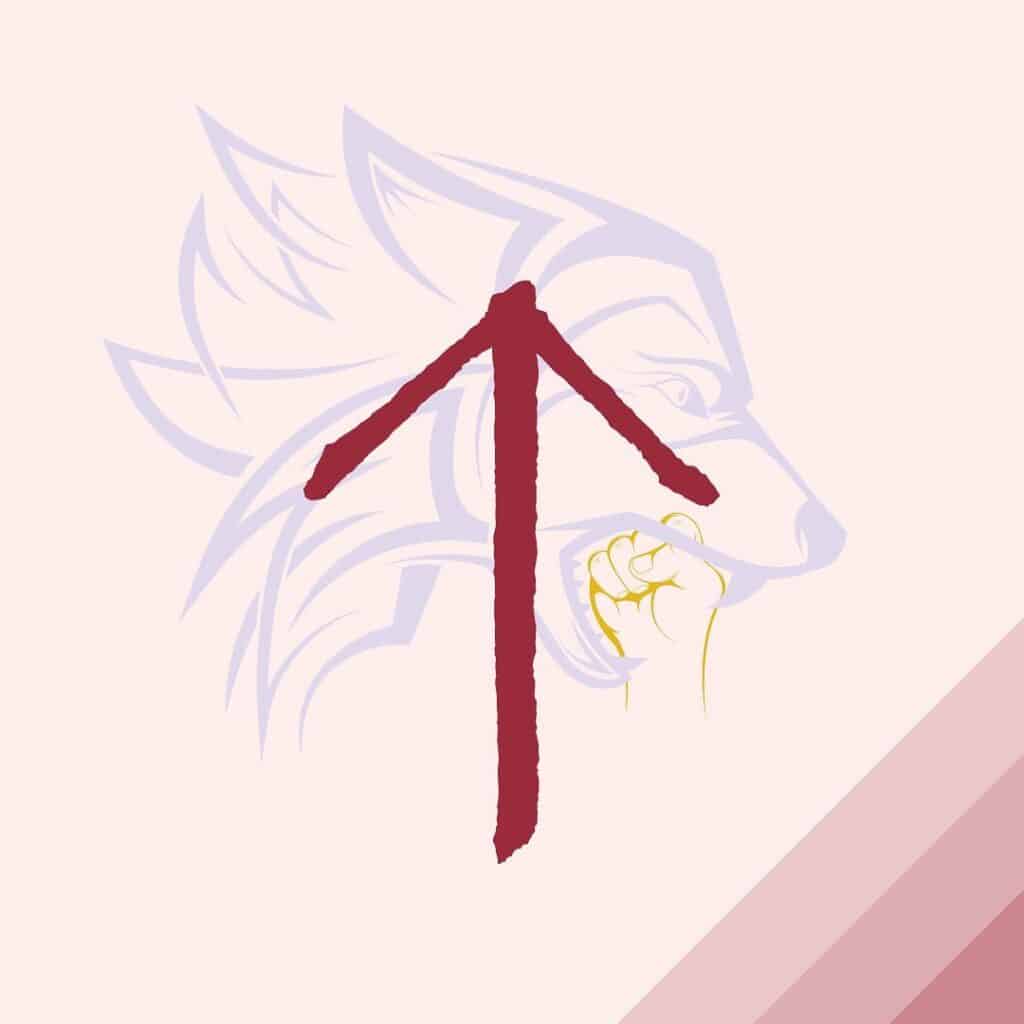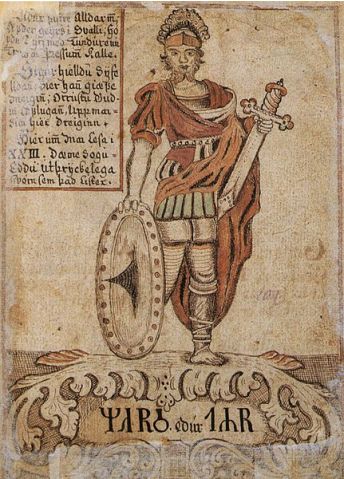Picture this: a Viking warrior, his hand gripping a runestone etched with a unique symbol. This symbol, a simple vertical line, is more than just a mark. It’s a rune, a letter in the ancient Elder Futhark alphabet. And this particular rune, known as Tiwaz, carries a weight of meaning and history.
Now, let’s step into the world of the Tiwaz rune. Imagine the Viking Age, a time of exploration, conquest, and deep spiritual belief. At the heart of this belief system were the runes, each one a symbol with its own unique story. And the story, my friends, is one of justice, honor, and sacrifice.
Tiwaz: Background and Description
The Elder Futhark, the oldest form of the runic alphabets, was a system of writing steeped in mystery and magic. Its origins trace back to the 2nd to 4th centuries, with evidence found on artifacts like the Kylver Stone from Gotland, Sweden. The Tiwaz rune, the seventeenth in this ancient alphabet, sits between Sowilo, the rune of the sun, and Berkanan, the rune of birth. Its name, derived from the Old Norse word ‘Týr’, refers to the god of justice and law.
As the Elder Futhark evolved into the Younger Futhark, around the 8th century, the number of runes was reduced, but Tiwaz retained its place. Its enduring presence speaks volumes about its significance in the Viking Age. Justice, after all, was a vital force in Norse society.
Graphical Representation

The Tiwaz rune is a simple yet powerful symbol. Picture a straight vertical line, with an arrow-like inverted V at the top, like a spear pointing upwards. This is the essence of Tiwaz, a symbol that captures the unwavering resolve and justice associated with the god Týr.
Over time, variations of the this rune have appeared. Despite these variations, the core symbolism of remains unchanged – a beacon of justice in a chaotic world.
Phonetic Value
In the Proto-Germanic language, the Tiwaz rune represented the ‘t’ sound. As the Germanic languages evolved, this phonetic value remained consistent. Whether in Old Norse, Old English, or Old High German, it continued to be associated with the ‘t’ sound, further cementing its connection to ‘Týr’, the god of justice.
Symbolic Meaning of the Tiwaz Rune
The Tiwaz rune is a symbol of justice, honor, and sacrifice. Its Proto-Germanic translation, ‘Týr’, encapsulates its essence perfectly. He is, after all, a god known for his sense of justice and his willingness to make personal sacrifices for the greater good. It’s no surprise then that this rune is closely associated with the god, Týr.
In the Viking Age, justice and honor were more than just ideals. They were a way of life, deeply ingrained in the Norse culture. The Tiwaz rune, with its connection to Týr, reflects these deeply ingrained cultural beliefs.
The Aett and its Symbolism
The Tiwaz rune belongs to Tyr’s Aett, the last of the three aett’s, or groups of runes in the Elder Futhark. Each aett is associated with a specific Norse god or goddess, and in this case, it’s the steadfast god of justice, Týr.
Tyr’s Aett is a collection of runes that embody themes of justice, sacrifice, and balance, much like Týr himself, the god who sacrificed his hand for the greater good. The Tiwaz rune, with its symbolism of justice and honor, fits perfectly within this aett. It’s a beacon, much like Týr’s unwavering resolve, guiding us through the complexities of life.
The aett system is a crucial part of understanding the Elder Futhark. It’s not just about individual runes, but how they interact and relate to each other within their aett. The Tiwaz rune, as part of Tyr’s Aett, carries the god’s sense of justice and sacrifice, illuminating our path with its steadfast light.
Elder Futhark Quiz
Do you want to test your knowledge of Elder Futhark runes? Then this quiz is perfect for you!
Don’t forget to play our other games as well!
Tiwaz Used in Divination and Magic
Now, I must confess, I’m not one for divination or magic. But I can’t deny the fascination these practices hold for many. The Tiwaz rune, in runic divination, is often seen as a sign of justice, victory, and personal sacrifice.
Historically, runes were used in magic and spellwork, and Tiwaz was no exception. Its association with the god Týr made it a powerful symbol for invoking justice, honor, and sacrifice. While we can’t say for certain how the Vikings used specific runes in their spells, its symbolic meaning offers some intriguing possibilities.
Tiwaz in the Younger Futhark – The Unchanged Warrior
As the Elder Futhark slowly transformed into the Younger Futhark, also known as Norse runes, around the 7th and 8th centuries, Tiwaz, representing the god Tyr or victory, remained unchanged. It continues to symbolize the ‘t’ sound, reflecting the enduring nature of justice, honor, and victory. In the Younger Futhark, it is known as týr.
Frequently Asked Questions
It symbolizes justice, honor, and sacrifice.
It belongs to Tyr’s Aett in the Elder Futhark.
In the Proto-Germanic language, the Tiwaz rune represented the ‘t’ sound.
In runic divination, Tiwaz is seen as a sign of justice and victory. It was likely used in magic to invoke justice, honor, and sacrifice.
Featured Image Credit: BK, Public domain, via Wikimedia Commons


Runes were not used “ historically” for divination it’s a writing system there’s no evidence of them being used that way.
Hi Jake, great to hear that you found the post engaging! While I agree with you that we don’t know very much specifically about how runes were part of any divination ritual, there is actually lots of mentions of runes and divination/magic. Most relevant here I think is the “blótspánn”, which where a kind of wooden “chips” (tiles/pieces), engraved with runes. They were used to “consult the will of the gods, consult what fate has in store”, basically divination.
I’m actually working on an article on Blotspon, but it will be a little while before it’s done. Furthermore, conculding that runes were “just” a writing system kind of falls short of all the actual evidence there is for the belief thst different runes could have protective/healing/other properties. Runes carved on wood or bone pieces, might be worn, hidden, given to someone to help/curse someone etc.
Hope you’ll be back and that greatly appreciate any comments!